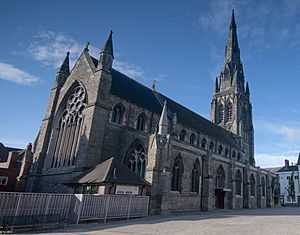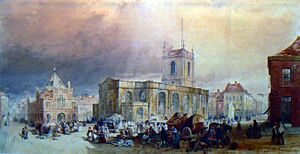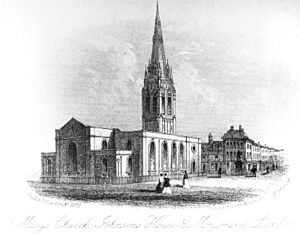St Mary's Church, Lichfield facts for kids
Quick facts for kids St Mary's Church, Lichfield |
|
|---|---|
 |
|
| 52°41′01″N 1°49′39″W / 52.683561°N 1.827403°W | |
| Location | Lichfield, Staffordshire |
| Country | England |
| Denomination | Anglican |
| Architecture | |
| Functional status | Active |
| Heritage designation | Grade II* |
| Architect(s) | James Fowler |
| Style | Gothic Revival |
| Completed | 1870 |
| Specifications | |
| Spire height | 55m |
| Materials | Rock-faced Derbyshire sandstone with ashlar dressings |
| Administration | |
| Parish | Lichfield |
| Diocese | Lichfield |
| Province | Canterbury |
St Mary's Church is a special building in the middle of Lichfield, Staffordshire, England. It stands on the south side of the market square. People believe a church has been on this spot since at least 1150. The building you see today was finished in 1870. It is a very important historical building, listed as Grade II*.
The church building was updated in the early 1980s and again from 1997 to 1999. Now, it serves many different purposes. On the ground floor, you can find Lichfield Library and the Tourist Information Centre. Upstairs, The Hub at St Mary's has a coffee shop, an art gallery, a special exhibition, and a space for performances.
Contents
History of St Mary's Church
The First Churches
The St Mary's Church building we see now is actually the fourth one on this site. It is thought that the very first church was built around 1150. This was when the town of Lichfield was first planned out by Bishop Clinton. The church was first mentioned in records in the 1200s.
In 1291, a big fire destroyed most of Lichfield, including its churches. St Mary's was rebuilt in the 1300s. This new medieval church had a main area, side aisles, a tower, and a tall spire. The tower was likely built in 1356.
During this time, St Mary's became very important in Lichfield. It was the church for the guild of St Mary and St John the Baptist. This guild was formed in 1387 by joining two older guilds. It helped manage the city's affairs until 1538.
From the 1600s, the north side of the church became the burial place for the Dyott family. They owned Freeford Manor. The current church still has a special chapel for the Dyott family on its north side.
The tower and spire of the medieval church often had problems. The spire fell down in 1594 and again in 1626. Many repairs were done in the 1600s, but it fell again in 1716. This collapse led to the church being rebuilt, starting in 1716.
The church's old records begin in 1566. They include the baptism of Samuel Johnson, a famous writer. His baptism would have happened in the medieval church.
The Neoclassical Building (1721–1868)
After the spire fell in 1716, people decided to pull down the medieval church. A new church was designed by architect Francis Smith of Warwick. It was built in a Neoclassical style. This style used ideas from ancient Greek and Roman buildings.
Money for the new church came from public donations and local trusts. Construction took five years and was finished in 1721. Samuel Johnson likely saw this building being built during his childhood. The main part of the church was made of brick. The old medieval tower was kept but covered in stucco, a type of plaster. The new church had a main area, side aisles, galleries, and the old tower.
Big repairs were done in 1806 and 1820 by Joseph Potter the Elder. In 1820, the brick outside of the church was also covered in stucco.
By the mid-1800s, many people wanted to rebuild the church again. They wanted it in a Victorian Gothic style. This new building would also honor Rev. Henry Lonsdale, a former Vicar who died in 1851.
In 1853, the tower was made shorter and changed to a Victorian Gothic style. A new steeple was added, designed by George Edmund Street. He also designed a plan for the main part of the church. However, there wasn't enough money to start building the main church until 1868. For 15 years, the church looked a bit odd. It had a Gothic tower and spire, but the main body was still in the older Neoclassical style. The main part of the church was pulled down in 1868, after standing for 147 years.
The Present Building (1870 – Today)
The church building you see today was completed in 1870. It was built in a Victorian Gothic style using Derbyshire sandstone. The architect was James Fowler. It is not known if he used any of G. E. Street's earlier designs. The Lonsdale family helped pay for much of the building.
When finished, the church had a main area, a special chapel for the Dyott family, and the tower and spire from 1853. The lower part of the tower was very old and needed rebuilding. So, much of it was rebuilt in 1868. Charles Bateman added colorful decorations inside the church in the early 1900s.
From the 1930s, fewer people lived in Lichfield city center. Shops and businesses moved in, and people moved to the suburbs. This meant fewer people attended St Mary's Church. A large church that could hold 900 people was no longer needed. By the 1970s, a group was formed to save the historic building from being abandoned or torn down. They suggested turning it into a building that could be used for many different things by the community.
The plan was for the church to have five parts: a social center for older people, a coffee shop, a gift shop, a heritage exhibition, and the Dyott Chapel would stay as a place for worship.
Work to change the church began in 1978. It was designed by Hinton Brown Langstone. The building work was finished in December 1980. The new center opened on May 30, 1981.
In 2018, a big renovation project costing £1.8 million began. St Mary's reopened, focusing on being a place for everyone in the community. Downstairs, it now has the new Lichfield Library, with over 200,000 books. Upstairs, there is a space used for community activities, events, music, performances, and many other things.
The old church areas of St Mary's and St Michael on Greenhill joined together. St Michael's became the main parish church. St Mary's was named a Chapel of Ease, meaning it's a smaller church that helps the main one. Together with St John's at Wall, they form a group of churches called the United Benefice. Sometimes, services are still held in the Dyott Chapel at the north end of St Mary's.



